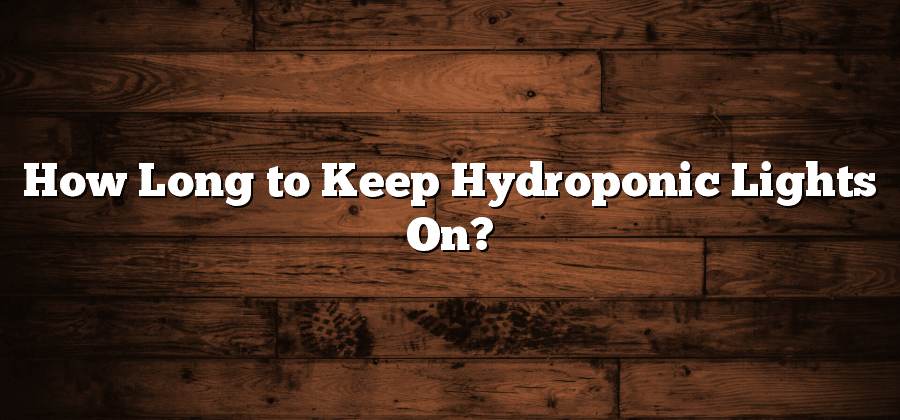Understanding the Role of Light in Hydroponics
Light is a crucial element in the success of hydroponics, playing a fundamental role in the growth and development of plants. Unlike traditional soil-based gardening, where plants receive natural sunlight, hydroponic systems rely solely on artificial light sources to provide the necessary energy for photosynthesis. The primary function of light in hydroponics is to mimic the sun’s rays and provide the essential wavelengths required for plant growth. This requires a proper understanding of light duration, intensity, and spectrum to create an optimal environment for the plants to thrive.
Light duration refers to the amount of time a plant is exposed to light each day. It is important to find the right balance as both insufficient and excessive light exposure can negatively impact plant growth. Different plants have varying light duration requirements based on their individual biological processes and stages of growth. Seedlings, for example, need less light than mature plants, while flowering plants may require longer light exposure to promote the production of blossoms. By carefully determining the appropriate duration of light exposure for each stage of plant growth, hydroponic gardeners can ensure that their plants receive the necessary energy for photosynthesis and reach their full potential.
Factors to Consider When Determining Light Duration
When it comes to hydroponics, determining the optimal light duration is a crucial factor in achieving successful plant growth. While it may seem tempting to keep the lights on all day to provide continuous photosynthesis, it is important to consider the specific needs of the plants at different stages of growth.
One of the main factors to consider when determining light duration is the type of plant being grown. Different plants have different light requirements, and understanding these requirements is essential in providing the ideal conditions for growth. For instance, some plants may thrive with 12-16 hours of light per day, while others may require as little as 6-8 hours. Additionally, the stage of plant growth also plays a role in determining the duration of light exposure. Seedlings, for example, may require less light compared to mature plants. By taking these factors into account, growers can ensure that their plants receive the optimal amount of light for healthy and productive growth.
The Importance of Light Intensity in Hydroponics
Light intensity plays a crucial role in hydroponics as it directly affects the photosynthesis process in plants. Photosynthesis is the process where plants convert light energy into chemical energy, resulting in the production of glucose or food for the plant. Without sufficient light intensity, plants may struggle to carry out this process efficiently, leading to stunted growth and reduced crop yield.
When it comes to hydroponic systems, the light intensity requirements may vary depending on the type of plants being grown and their growth stage. In general, high-light plants, such as tomatoes or peppers, require higher light intensity compared to low-light plants like leafy greens. It is essential to understand the specific light requirements of each type of plant to ensure optimal growth and development. Furthermore, it is crucial to adjust the light intensity as plants progress through different growth stages, such as seedling, vegetative, and flowering stages. Adequate light intensity throughout these stages is necessary to promote healthy plant growth, the synthesis of essential nutrients, and the development of vibrant and productive crops.
Different Stages of Plant Growth and Light Requirements
Plants go through various stages of growth, each with specific light requirements for optimal development. Understanding these stages and their corresponding light needs is crucial for successful hydroponic cultivation.
During the seedling stage, when a plant is just starting to grow, it requires lower light intensity and shorter daily light durations. Seedlings are delicate and can easily become stressed or burned by excessive light. Providing them with gentle, indirect light for around 10-14 hours per day is usually sufficient. As the seedling grows, gradually increase the light intensity to encourage stronger stem and leaf development.
Moving on to the vegetative stage, plants require longer periods of light exposure to support vigorous growth. This is the stage where the plant focuses on leaf and stem development rather than fruit or flower production. Providing plants with 16-18 hours of light per day during this stage promotes healthy foliage and helps establish a robust root system. Additionally, maintaining a moderate to high light intensity ensures that the plant receives sufficient energy for photosynthesis and overall growth.
Finding the Optimal Light Schedule for Hydroponic Plants
When it comes to growing plants using hydroponics, finding the optimal light schedule is crucial for ensuring healthy growth and maximum yield. Light plays a significant role in the photosynthesis process, where plants convert light energy into chemical energy, fueling their growth and development. Understanding the light requirements of different plant species at different stages of growth is essential for creating an effective light schedule.
Factors such as light duration and light intensity need to be carefully considered when determining the optimal light schedule. The duration of light exposure refers to the number of hours that plants are exposed to light each day. Different plant species have varying light duration requirements, with some needing shorter periods of light exposure and others requiring longer durations. Additionally, the intensity of light, measured in lux or foot-candles, also affects plant growth. Higher light intensities are typically required during the vegetative stage, where plants need more energy for leafy growth, while lower light intensities are often sufficient during the flowering and fruiting stages. By adjusting both the duration and intensity of light, hydroponic gardeners can tailor the light schedule to meet the specific needs of their plants, promoting optimal growth and productivity.
Overall, finding the optimal light schedule involves careful consideration of factors such as light duration and intensity. By understanding the specific light requirements of different plant species at different growth stages, hydroponic gardeners can create an effective light schedule that promotes healthy and abundant plant growth. continued..






